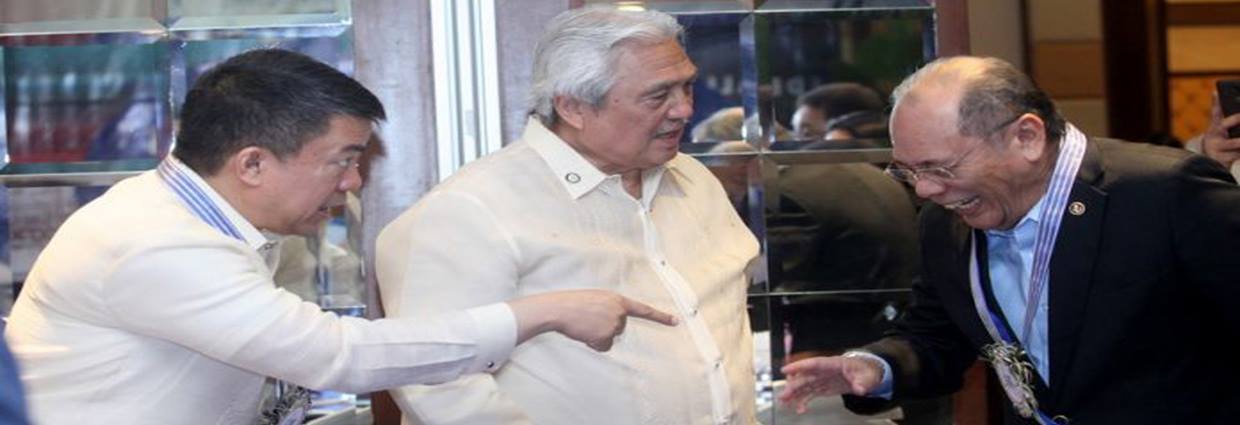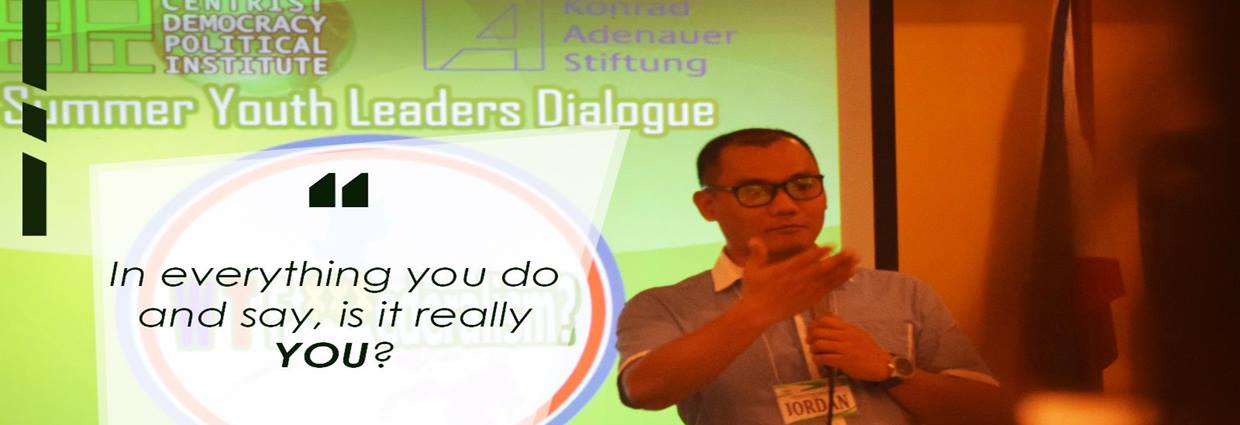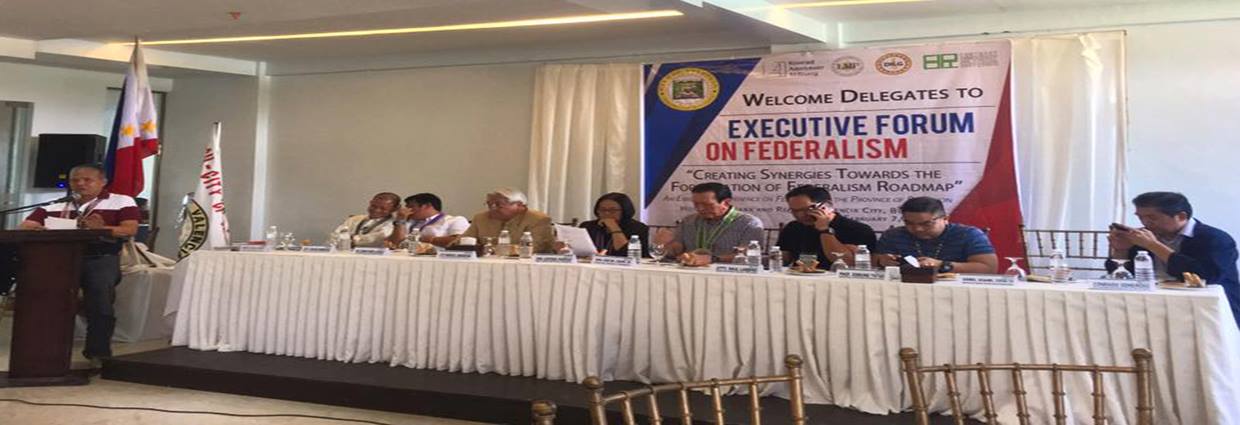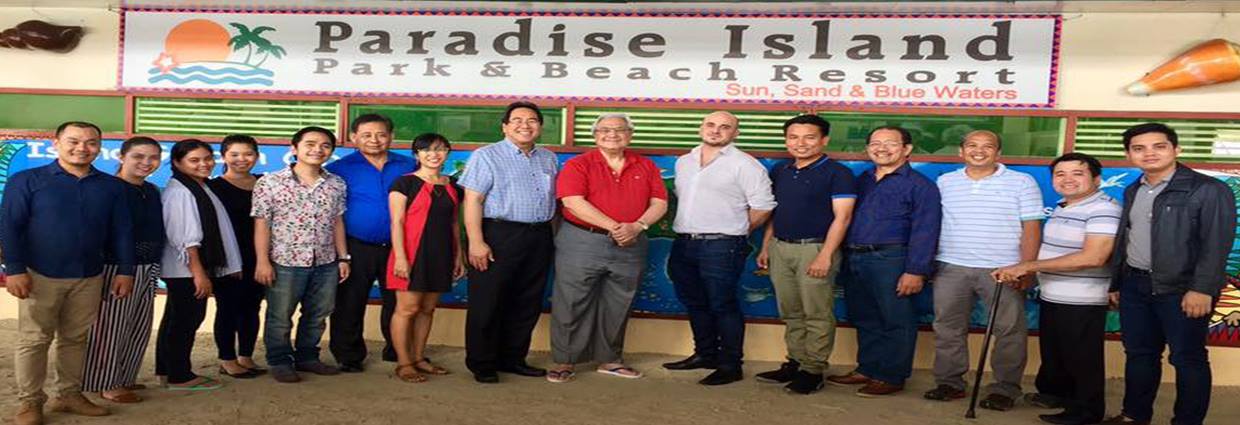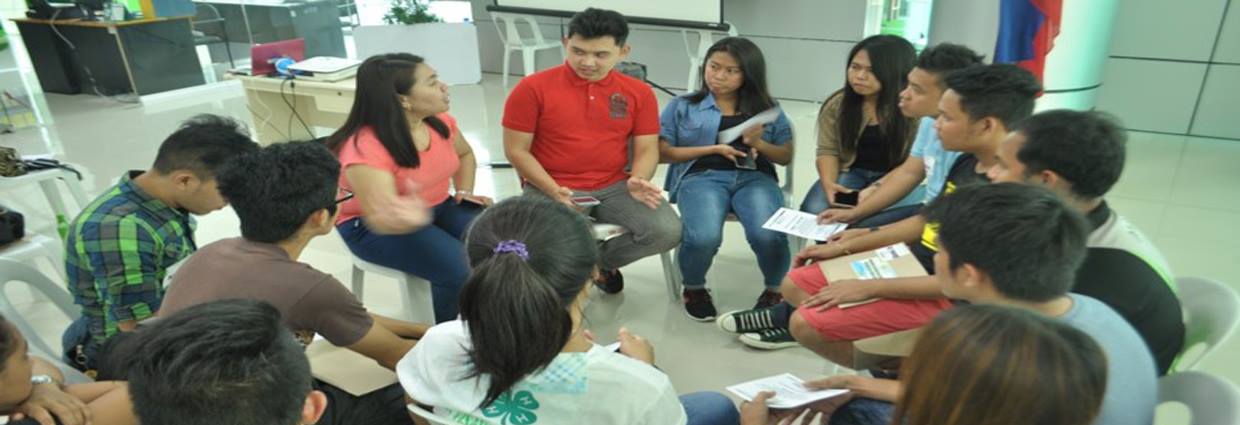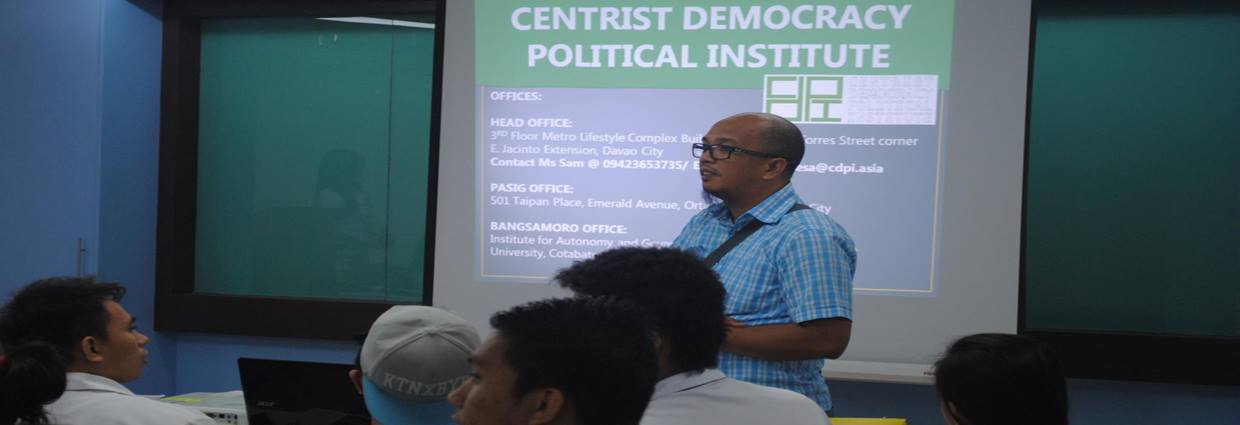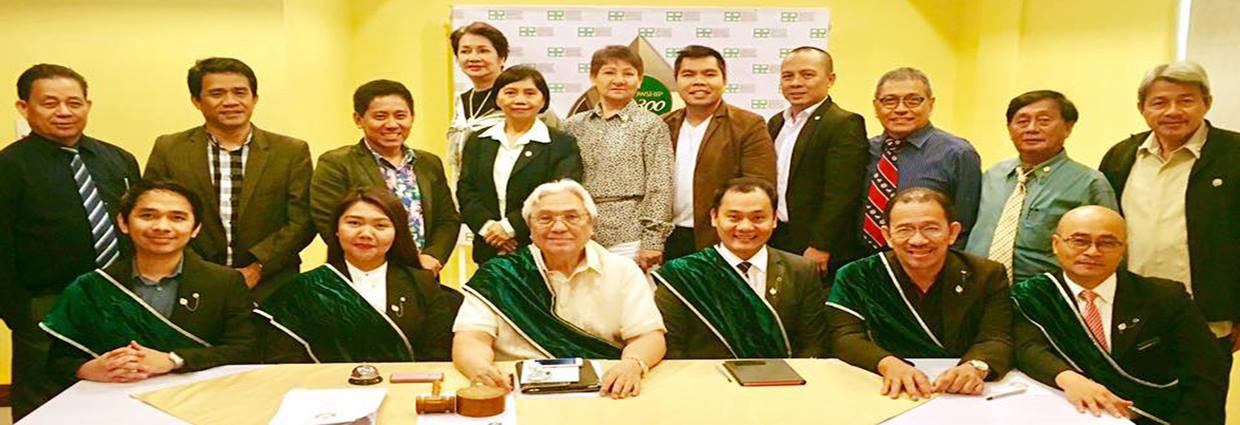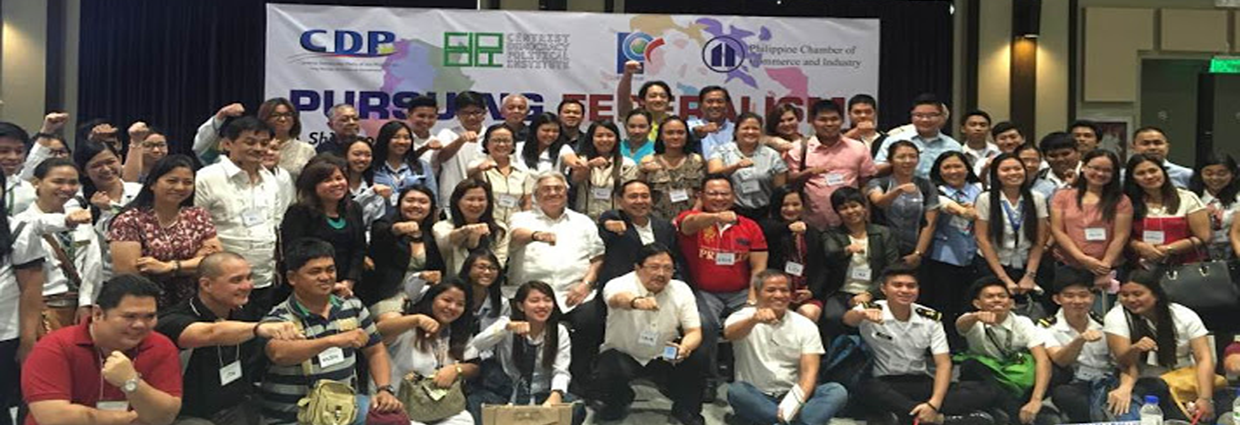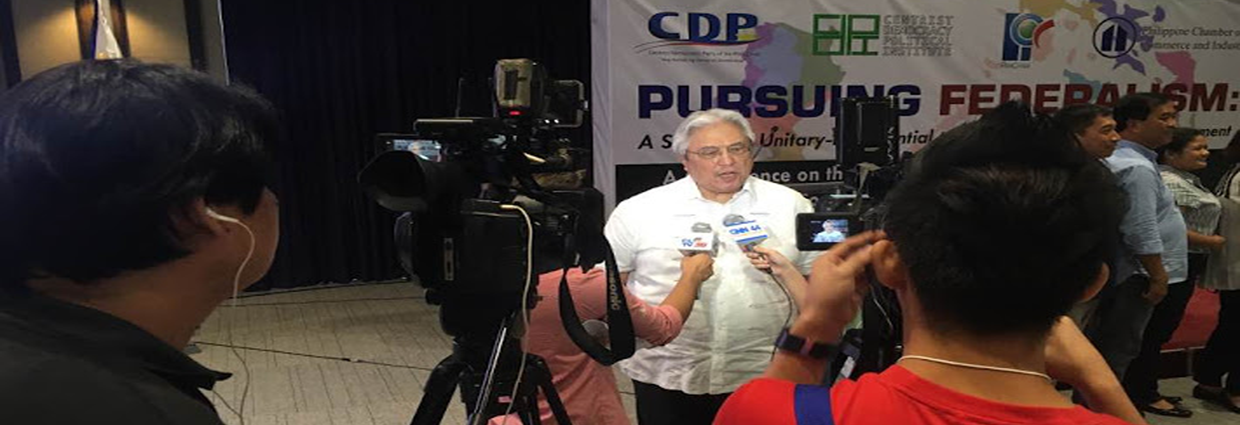Centrist Democracy Political Institute - Items filtered by date: December 2025
Thursday, 26 October 2017 09:58
Anatomy of a scam
A YEAR has gone by since the famous DU30 profanity against Barack Obama and subsequent Philippine “pivot to China.” His declaration shocked the world, especially the US government, which was in the midst of a presidential campaign that also propelled an “outsider,” the Donald, to the “most powerful presidency” of the Western world.
The Deegong’s declaration of non-alignment, or “independent” foreign policy, was hailed by China in its win column. It is unfortunate that China’s own setback at the Permanent Court of Arbitration, which rejected its 9-dash line claim to the South China Sea region, seems to have been reversed by the Philippines’ virtual acquiescence to everything that Beijing wants.
The Deegong, with the newfound confidence of a bit player in the global stage, proceeded to visit China with a historic full entourage of Cabinet men, business tycoons, well-connected bureaucrats and prospective Chinese middlemen contacts. Playing this role to the hilt, he subsequently declared “the Philippines, China and Russia together against the world.” Quite a number of Filipinos cheered with a vicarious thrill over this “global triumvirate.” We can only guess Xi Jinping’s and Vladimir Putin’s thoughts on this presumptuous pronouncement by an upstart “wannabee of a country” claiming a seat at the table with the superpowers. But they were the perfect hosts, leaving the Filipino entourage to cherish the moments as “legends in our own minds.”
On his triumphant return, the Deegong brought along goodies worth an estimated $24 billion consisting of two major parts.
• $9 billion, or about P450 billion, for some 40 proposed government-to-government, or G2G projects that have been proposed to be funded with loans from China; and
• $15 billion, or about P750 billion, for 27 proposed business-to-business, or B2B projects that will come from “direct investments” of Chinese companies in partnership with Philippine companies.
As a result, a new Philippine mantra has emerged: Build! Build! Build! The ambitious and unparalleled infrastructure projects of the Duterte administration could dramatically transform our landscape as these do not merely involve infrastructure but also transportation, agriculture, and inter-island bridge systems, and even energy and manufacturing. A memorandum of understanding and joint-venture agreements were signed for loans from China worth P1.2 trillion. It is estimated that about two million jobs will be generated. Not bad, for a four-day state visit.
But then, questions began to be asked.
In its excellent research, the Philippine Center for Investigative Journalism has identified Filipino parties involved in these deals. The information they have uncovered is rather disturbing. Twenty-two companies in the business-to-business deals have no track record in “doing big-ticket infrastructure projects”; and have inadequate operating capital and considerably small asset base. Two of the firms (Zonar Systems, MVP Global Infrastructure Ventures) only registered with the Securities and Exchange Commission after they signed MOUs with their Chinese counterparts sometime in November 2016 and January 2017. These unknown companies with multi-million-peso deals (on paper) whose “name-droppable” principals were in the entourage of PRRD to China could thus be inferred as the new cronies, “friends of the administration”. Shades of the Marcosian prototype.
Budget Secretary Benjamin E. Diokno said the preferential interest rate has not yet been discussed as the Chinese do not want other countries to get jealous as it will be much lower. This is what a slick secondhand car salesman will tell you supposedly in confidence. But would you seriously want to borrow money from the bank and not discuss the interest rate?
I talked to several government and private potential business partners. Their response: the Chinese just love to sign MOUs here and MOAs there. And funds…are they in place? Nada.
These deals are simply not even in the pipeline. Which brought me to research similar deals in other countries. Sri Lanka was one of the underdeveloped countries that similarly arranged for Chinese loans. Over the years, China has provided Sri Lanka loans for infrastructure which include a deepwater port, airport and railway projects. One of these, the Hambantota deepwater port, was built with loans with interest rates of 6.3 percent per annum, compared to the World Bank’s and Asian Development Bank’s 0.25 to 3percent. Sri Lanka was unable to pay, forcing it to an onerous debt-to-equity conversion that gave Chinese firms 80 percent share (and profits, if any) of the port over the 99-year lease period. Similarly, Chinese firms took over operating and management control of the nearby Mattala Airport, also built with Chinese loans.
China’s intentions are also suspect as the Sri Lankan port and airport “provides Beijing with a strategic military position in the event of an Indian Ocean conflict and is also key for its ‘Belt and Road’ initiative.”
According to knowledgeable government sources, in the proposed railways and other infra-projects for the Philippines, the joint-venture agreements call for the Chinese government to recommend three to five Chinese mainland contractors for the Philippine partners to choose from (no international public bidding); supplies and equipment must all come from China; Chinese personnel may have to be allowed to work in the projects; and accompanying long term-maintenance and service arrangements.
Shouldn’t we rethink these “soft and concessionary” loans from China in light of what we have already conceded? We have been silent and helpless on China’s encroachments on our claimed territories in the Spratlys archipelago, Reed Bank and Scarborough Shoal.
While the euphoria over this novel relationship struck with China still lingers, it may be prudent for the DU30 administration to examine more closely this new partnership lest we find ourselves later in a quandary on how to disembark from the tiger’s back. Let us learn from the lessons from past mistakes of China’s partnership with other Asian countries. We do not wish to be in any way near Sri Lanka’s fate.
Published in
LML Polettiques
Wednesday, 25 October 2017 10:45
Duterte restructures NEDA, DFA, BOC offices
Administrative Order (AO) No. 8 reconstituted the composition of the NEDA Board, Executive Committee (ExCom), and the Investment Coordination Committee (ICC) for a more effective and speedy approval process.
The NEDA Board, from 22 members, is now streamlined to 12 members, with the President, as Chairperson and Socio-Economic Planning Secretary, as Vice Chairperson.
The other board members are the Executive Secretary; Cabinet Secretary; Mindanao Development Authority (MinDA) Chairperson; Bangko Sentral ng Pilipinas (BSP) Deputy Governor; and the Secretaries of Budget and Management, Energy, Finance, Public Works and Highways, Trade and Industry, and Transportation.
Further, AO No. 8 reactivated the 6-member NEDA Board ExCom, headed by the President as Chairperson, and Socio-Economic Planning Secretary as Vice Chairperson; and restored the ICC, with the Finance and Socio-Economic Planning chiefs as Co-Chairpersons.
Parts of responsibilities of the NEDA Board ExCom are to approve development plans and programs consistent with the policies set by the President and confirm “extremely urgent” ICC-approved projects.
Meanwhile, Executive Order (EO) No. 46 reverted the post clearance audit function from the Department of Finance (DOF) Fiscal Intelligence Unit to the Bureau of Custom (BOC), in effect reviving the BOC Post Entry Audit Group and renaming it as Post Clearance Audit Group (PCAG).
“The PCAG is mandated to conduct, within three (3) years from the date of final payment of duties and taxes or customs clearance, an audit examination, inspection, verification, and investigation of records pertaining to any goods declaration,” EO No. 46 stated.
The BOC-PCAG will be headed by an Assistant Commissioner of the BOC who will have direct control and supervision of PCAG’s Trade Information and Risk Analysis Office (TIRAO) and Compliance Assessment Office (CAO).
On the other hand, the defunct DOF Fiscal Intelligence Unit was instituted and renamed as Financial Analytics and Intelligence (FAI) Unit. Among its functions include revenue-related data analysis, review of fiscal matters, and policy advisory.
Bringing consular services closer to Filipinos
Meanwhile, President Duterte, through Executive Order (EO) No. 45, reorganized the field offices of the Department of Foreign Affairs (DFA) Office of Consular Affairs-consisting of the Regional Consular Offices (RCOs) and Satellite Offices (SOs)-to form the DFA Consular Offices.
“In accordance to the Duterte administration’s goal of promoting a people-centered, clean, efficient, and effective governance, including seamless service delivery. There is a need to open additional consular offices in strategic places to ensure faster processing of passports and minimize inconvenience to the DFA’s clientele,” EO No. 45 said.
A total of 27 RCOs and SOs across the country renamed as DFA Consular Offices, which functions include issuance of Philippine passports and verification for consular record documents, and provision of authentication services and assistance-to-nationals (ATN) services to Filipinos.
Additional Consular Offices may be subsequently created by the DFA, subject to a set of criteria and the President’s approval, in a bid to provide consular services to the widest possible area across the country. (PCO-Content)
Published in
News
Tuesday, 24 October 2017 09:31
Palace tells Bautista his resignation is effective immediately
Malacañang has informed Commission on Elections chairman Andres Bautista that President Rodrigo Duterte has accepted his resignation, the election official announced on Monday afternoon.
Instead of being effective December 31 as he indicated in his resignation letter, Bautista said he was told that his resignation would be effective immediately.
"We refer to your letter tendering your resignation as Chairman of the Commission on Elections. Upon the instruction of President Rodrigo Roa Duterte, I wish to inform you that your resignation is hereby accepted, effective immediately," read Executive Secretary Salvador Medialdea's letter.
Bautista said he would no longer attend the Comelec's en banc meeting scheduled on Tuesday, adding that the en banc would have to decide who the acting chairman would be.
He said he had "mixed feelings" after he received the letter as he would surely miss his colleagues in the Comelec.
"Ang nakalagay (sa sulat) ay effective immediately (pagbibitiw sa puwesto). Kung ano man ang pasya ng ating Pangulo ay malugod nating tatanggapin. Mabuti rin na bigyan ng sapat na panahon yung papalit sa akin, para maging handa," Bautista said.
On October 11, the House of Representative voted to impeach Bautista, hours after he announced his resignation that was supposed to be effective by year end.
It was former Negros Oriental Representative Jacinto Paras and lawyer Ferdinand Topacio who filed the impeachment complaint against Bautista on August 23.
The complainants accused Bautista of betrayal of public trust due to his failure to address the hacking of the Comelec website in March 2015 and for failing to properly disclose his Statement of Assets, Liabilities and Net Worth.
The complainants also alleged that Bautista betrayed public trust for admitting that he had received referral fees from the Comelec's technology provider Smartmatic through the Divina Law Office, and for obstructing justice in saying that, pending investigation, the script tweak of the transparency server during the 2016 elections was "merely cosmetic."
When asked if the impeachment against him would be moot and academic, Bautista refused to comment further.
"Hayaan na natin. Sabi ko nga ayokong pangunahan ang kahit sino. 'Yun nga may sagot na ang Pangulo," Bautista said. —NB, GMA News
Published in
News
Tuesday, 24 October 2017 09:17
Government allocates initial P5-billion fund for Marawi rehabilitation
The government is allocating an initial P5-billion fund that will be spent until the end of the year for the rehabilitation of Marawi City, a Civil Defense official said Monday, October 23.
Assistant Secretary Kristoffer James Purisima said a big chunk of the fund would be allotted for the relief efforts.
“Ang priority diyan ay ‘yung patuloy nating pagbibigay ng relief sa ating IDPs (internally displaced persons),” Purisima said during the regular Mindanao Hour press briefing in Malacañang.
As of latest count, he said there are more than 72,000 IDP families still housed in evacuation centers as well as those who are home-based.
Purisima added that part of the 5-billion would also be used to fund the construction of transitional shelters.
The National Housing Authority eyes to build at least 1,100 transitional shelters within the year for the Marawi City IDPs, he said, adding that displaced persons may start occupying the shelters as early as next year.
“‘Yun ang target nila doon sa unang plano. Of course, this is subject to evaluation, this is subject to revisions as needed dahil ngayon minamadali na at tinatapos na ng DPWH ‘yung site development ng lahat ng transitional shelter sites. ‘Yung six areas diyan sa transitional shelter sites,” Purisima said.
The site development continues in Barangay Sagonsongan, Marawi City, under the leadership of the Department of Public Works and Highways.
A private company also volunteered to develop a water distribution system for the transitional shelter site in Barangay Sagonsongan and has identified location for installation of deep wells.
The government also accepts donations from foreign groups and it is being handled by the Finance and Resource Mobilization Support Group. Among the donors include Thailand, India and China, he said.
To address concerns on the lack of livelihood in the temporary sites, Purisima said the government is studying possible livelihood and business opportunities for the IDPs.
“At saka alam naman natin itong transitional shelter site ay transitional, temporary lamang, ngunit bibigyan pa rin natin sila ng sense of community dito sa transitional shelter site,” he said.
“So nagpaplanong maglagay diyan ng marketplace, maaaring maglagay din diyan ng eskwelahan at health center o medical center,” he added.
Aside from the appropriate livelihood interventions, the IDPs will also be provided appropriate health and educational interventions as well.
Meanwhile, Malacañang welcomed the tie-up between the Diocese of Novaliches, Quezon City and the Philippine National Police to rehabilitate drug dependents.
“The drug rehabilitation partnership agreement signed by the Diocese of Novaliches, Quezon City government, and the Philippine National Police for a community-based drug rehabilitation program in the Batasan area is a commendable move to pro-actively help the national government in the anti-illegal drug campaign,” Presidential spokesperson Ernesto Abella said in a statement.
“ It is hoped that this kind of partnership can be replicated by the PNP and other offices involved in the comprehensive anti-illegal drugs campaign with other Dioceses, as well as other churches and church groups in the country,” he added.
Abella noted that this kind of collaboration between the government and the Church is what the people expect, as indicated by a recent survey showing majority saying that the Catholic Church must help with the rehabilitation of drug addicts.
“The complementary work of the government and the Church in the treatment and rehabilitation of drug dependents must further be enhanced, particularly in areas such as restoration of mental, spiritual, and psycho-emotional health,” he added. (PND)
Published in
News
Friday, 20 October 2017 09:31
DTI to destroy P1.2-M non-conforming mandatory products
ILOILO CITY — More than PHP1-million worth of confiscated goods from violations of the Product Standards Law will be destroyed, marking this month’s Consumer Awareness Month celebration.
The confiscated items include hardware and general merchandize items from the provinces of Capiz and Iloilo in December 2016 that amounted to some PHP1.236 million.
The confiscated items from seven firms in Capiz included uPVC pipes, electrical pipes, sanitary wares and household electrical appliances that amounted to PHP910, 135.00. The firms paid a total of PHP70,000 in penalties.
Moreover, some PHP326, 691 worth of items were confiscated from seven firms in Iloilo in December last year. These included uPVC pipes, electrical products, sanitary wares, household electrical appliances and Christmas lights. From these firms, a total of PHP122, 500 fines were generated.
These items will be destroyed October 30, according to DTI-6 information officer David Sinay on Thursday.
Meantime, hardware items confiscated in six firms from Iloilo and four firms in Antique last July and June this year, respectively are still under adjudication.
DTI has monitored a total of 6,492 firms in Western Visayas for their compliance to various consumer laws. Of these, 2,161 were on Product Standards Law.
Earlier, Regional Director Rebecca Rascon said that DTI has prepared various activities to highlight consumer awareness. One of the highlights is also the awarding of Bagwis Award to 35 firms in the region.
The Bagwis Award is given to establishments that uphold consumer rights. The 35 awardees include four gold, 18 silver and 13 bronze awards.
Gold awardees are those that achieved the silver requirements plus some elements aligned with the ISO 9001; Silver for those that achieved bronze requirement with additional social responsibility and bronze for establishments that comply with the Fair Trade Laws and have established a consumer welfare desk or its equivalent inside the mall. (PNA)
Published in
News
Thursday, 19 October 2017 13:51
Crisis unites Muslims, Christians: Marawi prelate
DUMAGUETE CITY – Bishop Edwin dela Peña of the Marawi Prelature said the conflict in Marawi City had brought together Muslims and Christians, fostering brotherhood and providing a venue for compassion, help and understanding.
Working continuously to this day to provide relief and rehabilitation for the countless refugees who have fled Marawi City, Bishop dela Peña thanked the inestimable aid from various local and foreign donors for the displaced Muslims and Christians who have practically lost all that they owned.
The conflict in Marawi that is expected to soon come to an end has opened doors for Muslims and Christians to transcend religious barriers and work hand in hand to survive the consequences of the war, the prelate pointed out in an interview Monday evening.
Emphasizing cultural sensitivity where Maranaws and Christians were giving mutual aid to one another, he said that there were “beautiful stories about Muslim-Christian engagement, their mutual help for each other that we would like to highlight.”
“Mubati ta ug kalooy sa usag usa (we feel compassion for each other”), he added.
The Marawi bishop is hopeful that the experiences of the war will change the way “we look at them (Muslims) and that it will break the cycle of prejudices and biases.”
The Marawi prelate presided the Holy Mass during the 58th Alumni Homecoming of the St. Joseph Seminary of the Diocese of Dumaguete on Monday evening.
In his homily, he spoke of the pain and agony of the people of Marawi since Day 1 of the conflict until now.
The bishop, who hails from nearby Siquijor Island and an alumnus of the St. Joseph Seminary here, recounted the painful experiences the Catholic Church in Marawi had gone through, to include the kidnapping of one of the priests, Fr. Teresito “Chito” Suganob and some staff.
He expressed gratitude that Fr. Chito and another hostage of the Maute terror group were rescued last month but it was unfortunate that two of their working students who were taken along with the priest as hostages did not make it.
He disclosed that prior to the siege in Marawi by the extremist Maute terror group, the Church had already known that they were to be targeted, that priests and people living there would be killed.
“That was the original plan of the terrorists — to cleanse Marawi of Christians whose presence in an Islamic City is an anachronism and Muslims who do not live up to the true spirit of Islam,” dela Peña told alumni-priests and former seminarians in his homily.
Fr. Chito is still undergoing debriefing after having gone through a traumatic experience and it is going to be a long process, Bishop dela Peña said.
The priest thinks he is still with the ISIS and is going through very rough times, the bishop added.
Three of their women-hostages had also been freed recently, along with others, as the leadership of the Maute group has crumbled, Bishop dela Peña added.
Expressing thanks amid the tragedies of the war in Marawi, Bishop dela Peña highlighted humanity as a means to fight terrorism.
“There is much violence, lots of senseless killings. Violent extremism can only be countered by our common experience of our humanity, that we are all humans, that we feel the same for one another,” he stressed.
“Really, we should thank the Lord for such an experience that has brought us to a realization that we really should not take our faith for granted. We have to promote what is best for humanity”, he added.
“Now that the leaders of the Maute Group, Isnilon Hapilon (the supposed emir), and Omar Maute have been killed in a clash with government troops, I believe the war is already over,” said de la Peña.
The biggest challenge now for the government and for the different sectors is the relief and rehabilitation efforts of what is left of Marawi City, the prelate noted. (Mary Judaline Partlow/PNA)
Published in
News
Thursday, 19 October 2017 11:11
Federalism as a grand bargain
First of 2 parts
THE ruling Partido Demokratiko Pilipino-Laban ng Bayan (PDP-Laban) recently submitted to the House of Representatives its proposal for constitutional amendments. There has been a lot of apprehensions regarding our shift to a federal form of government. For example, Winnie Monsod fears that federalism will lead to the strengthening of political dynasties and more corruption in the regions. Sen. Ralph Recto is concerned that there will be more layers of bureaucracy and red tape and hence more taxes. Former senator Edgardo Angara Sr. has expressed some concern over the potential break-up of the country if, for example, one region discovers huge oil and gas reserves and no longer needs transfers from the national government.
Professors at the University of the Philippines rhetorically ask: “If federalism is the answer, then what is the question?” What would happen to the party list? What about the administrative capacity of the regions? Businessmen and investors are rightly worried how federalism, especially taxes, would impact their businesses. Would the shift to federalism slow down our growth momentum? Would a presidential, parliamentary or a hybrid form of government be suitable for Philippine-style federalism? Why do we need to change the Constitution and why not just amend the Local Government Code to give more powers to the regions?
The PDP Laban draft constitution—drafted by experts under the guidance of Senate President Koko Pimentel, the PDP-Laban president—recognizes these concerns as valid. The draft constitution in fact proposes the shift to federalism as a grand bargain, a package of reforms. These reforms include: 1) constitutional restrictions on political dynasties; 2) shift to a dual executive or semi-presidential form of government; 3) banning of political butterflies; 4) strengthening of political parties; 5) shift to proportional representation; 6) strengthening of constitutional bodies in the regions, particularly the commissions on civil service and audit; 7) reducing the duplication of work between the Senate and the House of Representatives; and 8) judicial reforms, including strengthening of the Sandigan Bayan, appellate courts and Ombudsman at the regional levels.
Tinkering with the Local Government Code alone would not be sufficient.
From political dynasties to political parties
One of the main apprehensions about federalism is that the transfer of significant powers to the regions will only perpetuate political dynasties. Not all political dynasties are the same, however. Some contribute more to the public good than others. Some political dynasties are fat-tailed—with many members of clans simultaneously occupying positions of power—while others are thin-tailed. Political dynasties themselves are not to blame. The proliferation and durability of political dynasties came about, in large part, because of the failure of the 1987 Constitution to pass a self-enforcing provision regulating these dynasties. This mistake has to be corrected. We need a self-enforcing constitutional provision regulating political dynasties, without which the transfer of more powers to the regions would be at risk of political capture.
But why do we need to regulate political dynasties? Why not just let the voters decide? There is a problem with this argument. First, voters decide based on what choices are available to them. If the only options are familiar names of political dynasties, then naturally voters choose the candidates they like most. Candidates do not have incentives to differentiate themselves on the basis of policies and programs. The solution to this is to give voters choices in terms of policies and programs and not just familiar names. This way they can hold political parties accountable. At present, politicians cannot be held accountable for failed promises because their policy positions are unclear. For this, we need to shift from elections based on personalities to one based on political parties with distinctive policies and programs. For this reason, we need to strengthen our political party system.
Most successful federal systems of the world depend on strong political parties and not families or personalities. To have strong political parties, we need to 1) shift to a semi-presidential form of government; 2) ban party switching or balimbing; 3) provide state subsidy for political parties as they do in Europe; and 4) ensure party discipline as they do in all parliamentary systems. What happened to the confirmation hearings of the appointees of President Duterte – Gina Lopez, Rafael Mariano and Judy Taguiwalo – is an instructive example. Members of the ruling coalition voted against them while members of the opposition supported them.
Semi-presidential form of government
Why would a semi-presidential form of government be better than a purely presidential or parliamentary system if we are to shift to a federal structure?
A presidential system of government is most familiar to Filipinos. It reduces uncertainties in the transition to federalism. Its main disadvantage is the over-centralization of powers, such as what we have now, the difficulty of removing the president if he becomes corrupt or abusive and the potential for gridlock with the parliament. The problem with gridlock has been partly solved via the pork barrel mechanism and a system of patronage with local governments.
A parliamentary system of government is more efficient in terms of lawmaking and policy implementation. There is no problem of gridlock and unfunded mandates because members of the cabinet come from the parliament. It also has strong mechanisms of accountability via vote of no confidence and question time. Indeed, most federal systems in the world have parliamentary governments—except, for example, the US, Russia and Mexico where they have popularly elected presidents. Its main disadvantages include the following: 1) strong parliaments rely on strong political parties which we currently do not have now; 2) most likely in the initial years of transition to federalism there will be a proliferation of political parties along regional, ethnic and ideological lines; therefore, parliaments can be unstable, especially if the ruling party comprise a coalition of parties. As a result, we could have a weak and unstable ruling government.
A semi-presidential form of government brings together the pros and cons of both presidential and parliamentary systems. In my view, this is the best system if we are to shift to a federal form of government. Let me explain why. First and foremost, the transition to federalism will be challenging and therefore, ironically, we would need a strong national leadership. There will be inherent resistance from national government agencies which will lose their powers and budgets. There is a need to strengthen the capacities of the regions—the middle government—to assume these powers. There will be many implementation issues to be sorted out. A decisive president is needed to ensure a successful transition to federalism.
Second, it is better to have a collective leadership with more horses pulling the wagon together—the president, prime minister, the cabinet, regional governors and local governments—compared to the current highly centralized presidential system. Collective and cohesive leadership has proven to be an effective arrangement for the rapid growth of highly decentralized developing countries such as Vietnam and China. Both countries have a president as the head of state and who looks after national security and foreign affairs, a prime minister and cabinet which looks after economic and social policy, and governors who execute policy on the ground.
Published in
Commentaries
Thursday, 19 October 2017 11:05
Disappointment and reset
WHAT a huge disappointment the Duterte administration has evolved into after so much hope and hype were generated from the election. Instead of bold moves to restructure the country towards more manageable governance units, not much actual progress towards a unified vision with gameplan and timeline of transforming into a federal government has been achieved. The drug war has been discredited with outlandish claims of police “fighting back” and investigating vigilante killings that some count as high as 7,000 dead in total.
The Duterte administration seems to be expending much energy in fighting the previous administration’s leaders and current critics. Incredulous statements defending the administration’s performance to date weaken the credibility of the government. You cannot govern effectively for long when credibility is diminished.
The political meltdown gripping the nation clearly shows that the Philippines is losing ground and time, and showing again that it is not governable as a unitary state and while federalism will take time, President Duterte must reset the national political discussion and move away from the old subtext of persecuting personalities and move boldly into taking concrete steps towards the national vision he laid out when he ran for president. Time is running out because after another year of this governance crap, the pull of the mid-term election will release mega money for all kinds of media plays that will confuse the average Juan will all sorts of BS.
Empower regional governance now
No, something big, like real change, must happen so that a chance at unity towards a better Philippines can take place. I would say that empowering regional governance now through executive fiat is a much better call than to threaten a “revolutionary government for the remainder of my term.” The latter doesn’t open genuine debate, rather, it engenders dissent, fear, anger, hopelessness, etc. and ultimately opposition based on personalities who said this or that, not the substance that we need to talk about to move forward for the sake of our youth. That RevGov is not only unnecessary, but it certainly won’t work, generating divisive heat and will set back his legacy of systemic change.
The proposal therefore to improve governance now is to empower the existing regional development councils and transform them into “regional development authorities,” or RDAs, through an executive order. It will be recalled that such bodies and authorities are already included in Article X, Section 14 of the Constitution. (The President shall provide for regional development councils or other similar bodies composed of local government officials, regional heads of departments and other government offices, and representatives from non-governmental organizations within the regions for purposes of administrative decentralization to strengthen the autonomy of the units therein and to accelerate the economic and social growth and development of the units in the region.)
What will the RDAs be managing? It is proposed that the RDAs manage the central government functions that have not been devolved to the local government units and supervise the faithful implementation of all laws that call for LGU implementation. We should see the national government in charge of “steering” and the LGUs doing the “rowing.” Correct ordering is a key principle of management, particularly if the desire is to unleash human potential.
Thus, national policy direction on economic development, environmental and natural resources, public works and highways, education and culture, justice, etc. will be set by the national government through the various Cabinet secretaries and the President, but the translation to regional and local action plans and budgets will be done by the regional development authorities (present RDCs on steroids so to speak). Again, the transformation of toothless RDCs into national partners in nation-building with real budgets and power is something that can be legally done by presidential executive order without need for legislation as the constitutional language is such that it is self-executing (unlike the anti- political dynasty provision).
What RDAs can manage
In short, it is proposed that the RDAs receive presidential authorization to manage, on its behalf the following functions: directly supervise BIR revenue districts in the region, strictly enforce people’s participation and “bottom-up” planning stated in the Local Government Code; enforce the E-commerce Law by having LGUs display in websites their budgets and expenses; directly supervise the PNP units in the region; ensure rationale regional and local land use and sustainable development plans; grant permits in the use of natural resources; and, directly supervise the regional line agency directors to ensure support for the LGU developments.
Imagine the Filipino potential that will be unleashed when regional line agency functions, talents and budgets are now programmed by the regional development actors and aligning these budgets with the budgets of the component LGUs. In fact, even congressional “pork barrel” can be programmed from regional budgets making their project choices better aligned with regional development and at the same time making them more accountable.
A typical regional development council has a membership 75 percent from the government, which includes elected officials like governors, mayors of chartered cities and regional line agencies like the DPWH, DoH, DA, DENR, etc., and 25 percent from the private sector, including NGOs and POs.
Note that the RDAs will be beyond the control and influence of any one or two existing political dynasts of component cities and provinces as they would be greatly outnumbered and none of the power handles (police, control over budgets) will be under their discretion. In fact, on the contrary, these local warlords will see their powers clipped dramatically, allowing more rational development initiatives to flourish at the sub-regional level.
Currently, something like 50 percent of the total government budget is spent by the regional offices of the line agencies but the spending is dictated by the national and not the component regional local governments. For our own sake, let’s rationalize that huge amount of money and democratize it and at the same time awaken the largely apathetic locals due to lack of power and money. This alone can dramatically change the direction and tone of political discourse nationally and in each of the 17 regions that make up our country.
Published in
Commentaries
Thursday, 19 October 2017 10:25
Federalism as a grand bargain
Last of 2 parts
THIRD, a decisive and stable leadership is needed to deal with many outstanding national security issues that the country is facing and will continue to face in the years ahead—the war on drugs, terrorism and US-China relations. There is no certainty that a prime minister at least in the transition period can provide decisive and stable leadership. The prime minister has to constantly rely on the support of a majority in the parliament, each one of them representing powerful factions. Under these conditions, a prime minister can easily be weakened by factional infighting. A semi-presidential form of government provides a balance between decisiveness of a presidency and accountability in a parliamentary system.
Fourth, a presidency is needed to deal with gridlocks and instability associated with parliamentary systems, especially in a transition period where political parties are very weak. A sudden shift to a pure parliamentary system without a stabilizing and familiar anchor is risky. This has been the experience of countries which swung from presidential to parliamentary systems. In the long run, when our parliamentary system has become strong, we can shift to a full parliamentary system. Most federal forms of government in fact are based on parliamentary systems.
Proportional representation
For a semi-parliamentary form of government to be effective, it has to be stable. For this to happen, the ruling party should have a comfortable majority in parliament. Ideally, there should just be a few national parties—like in the case of federal countries such as the US, India, Russia, Germany, Malaysia, Australia, among others.
We can also take lessons from parliamentary democracies such as Japan. Before 1990, around 50 percent of all elected posts in Japan’s House of Representatives (HoR) were controlled by political dynasties. Today it is about 10 percent. In the 1990s, elections were based mainly on personalities and not issues. Today, elections in Japan are now based more on political party platforms. Political parties have become central to Japanese politics and voters choose on the basis of policies rather than personalities.
What did they do? In the mid-1990s, they introduced a type of proportional system of representation called mixed-member majoritarian (MMM) method of voting with dual candidacy. Before that, they used single non-transferable voting (SNTV). Their goal was to shift from patronage/personality-based competition towards two-party competition, party-centered campaigning, and party centralization.
Under MMM, voters have two votes. One is for the single-member district (SMD) like what we have now, and the other vote is for a political party with dual candidacy (i.e. you can be nominated for both SMD and as party representative). Half of all HoR seats were allotted for SMD and the other half to the open list. Party leaders choose the candidates.
Twenty years after this reform, studies have shown that: 1) the goals of two-party competition, party-centered campaigning, and party centralization have been achieved; 2) patronage/factions remain strong but their effects have been channeled towards intra-party politics; 3) clientilistic policies (local public and private goods) are giving way to much broader national public goods; and 4) the dual candidacy has resulted in incumbency advantage. Even after 60 years in power, the Liberal Democratic Party (LDP) only managed to get 3.2 percent of district voters to sign up for party membership.
In addition to MMM, there are other possible mechanisms to channel the interests of political dynasties. For example, the effects of political dynasties are likely to be exacerbated in poor/rural regions but not in urbanized areas (perhaps due to the middle class). We also know that political dynasties are organized around provinces, cities and towns.
Therefore, if we have a regional governor who is elected at large by voters from provinces, cities and rural areas (and even OFWs), the incumbency advantages of political dynasties at the regional level will be mitigated. The downside is that smaller provinces might be initially disadvantaged by bigger ones (Bohol vs Cebu, Aurora vs Nueva Ecija, Pangasinan vs Ilocos Sur etc. under the current set-up). However, leaders from the smaller provinces could always coalesce and become large enough to have stronger bargaining powers.
What would happen to the the party-list system? Under the proportional system of voting following the Japanese model, the current party-lists would be regarded like any other political party. Instead of being limited to a maximum of three seats, party-lists can compete for as many seats as they can as a proportion of the total number of votes they receive up to a maximum of 40 percent of the total number of seats in the House of Representatives. The regulation of political dynasties would help ensure that smaller political parties can also compete in the regions.
Strengthening governance in regions
There are two other valid worries of both critics and proponents of federalism that should be addressed. The first is the problem of uneven administrative capacities in the regions—some regions are strong while many are weak. The second is the problem of decentralized corruption that could result from the transfer of more significant powers of the regions. The solution to this is to commensurately strengthen the powers and capacities of constitutional watchdogs such as the Commission on Audit and Civil Service Commission to prevent the abuse of power. Much remains to be done also to improve the governance of local government units as they are given more powers and responsibilities.
One way to ensure that the regional governments would have the capabilities commensurate with the transfer of significant powers and budgets would be to transfer existing regional government agencies to the control of a regional governor. At present, these agencies are held accountable by their head offices in Manila, and provincial governors have little influence over them. The regional offices of the National Economic Development Authority will play in a key role in regional budget and policy planning, monitoring and coordination and reporting directly to the regional governor. The capacity of middle government—the regional government—would also have to be substantially strengthened. Successful parliamentary systems in fact are associated with a strong civil service.
This arrangement has many important advantages. First and foremost, there is no need to create another layer of bureaucracy and hence no additional cost for personnel. Second, the directors of these agencies will continue to report to their former head offices for purposes of coordination over technical standards and policy implementation. This is an arrangement called dual reporting system similar to the arrangement of the administrative staff of India. Third, regional civil servants will be subject to the same national professional qualifications standards to ensure consistency of qualifications nationwide. Civil service will remain national in character.
In addition to strengthening the regional civil service, there is also a need to strengthen the commission on audit and special courts such as the Sandiganbayan and the Ombudsman at the regional levels. The goal is to ensure that these agencies can effectively hold regional and local governments accountable and to allay fears about abuse of power and decentralized corruption.
In conclusion, for federalism to succeed, we need a grand bargain, a package of mutually reinforcing political, electoral and administrative reforms. Tinkering with the Local Government Code will not be enough. Doing so without this package of reforms would be risky and would likely lead to failure.
Published in
Commentaries
Wednesday, 18 October 2017 11:56
President Duterte declares liberation of Marawi City
President Rodrigo Roa Duterte on Tuesday, October 17, declared that Marawi City has been liberated from terrorists after more than four months of battle against the ISIS-inspired Maute group.
“Ladies and gentlemen, I hereby declare Marawi City liberated from the terrorist influence that marks the beginning of rehabilitation for the people,” the Chief Executive said in his speech in Marawi City a day after Maute terrorist leaders Isnilon Hapilon and Omar Maute were neutralized by government troops.
“‘Wag na natin itong ulitin kailanman. Sa panahon ko, hindi ako papayag. Government must have access dito sa loob,” he added.
In his seventh visit to the Islamic City, the Commander-in-Chief also expressed gratitude to the government troops.
At the same time, he lauded the military and the police for their bravery.
“Maraming salamat at maligaya kaming mga Pilipino sa inyo. Mabuhay! Mabuhay! Mabuhay ang Armed Forces pati police! Matatapang, lalo na sa babae,” Duterte said.
The President also expressed concern for the government’s security forces who were wounded.
“Mga minahal kong sundalo, pulis, ang problema ko ang nasugatan ngayon. Marami ‘yan. ‘Yung iba nabaldado,” he said.
“I can guarantee you. Sinasabi ko na sa inyo ngayon, walang iwanan. Ipupwesto ko silang lahat,” the President said.
Nearly 1,000 people have been killed in the conflict, including more than 800 enemies, 47 civilians and 163 government troops since the rebellion started in May.
President Duterte: Old PUJs killing people
Meanwhile, President Duterte called on transport operators and drivers to modernize the public utility jeepneys (PUJs) as the old ones are already harmful to the public’s health.
“Kayong mga Piston, you know that you are poisoning the people. 2030, one-third ng Pilipino puro mahirap ‘yan mamamatay ng lung cancer,” the Chief Executive said.
“But change your machines, equipment because they are killing the people diyan sa carbon dioxide na ‘yan,” he added.
The President cited the program that would enable the operators to borrow from government and pay in tranches.
“Ang gobyerno may program, pinapahiram kayo ng pera. Ayan, bayaran ninyo dahan-dahan lang. Kung hindi niyo kaya ng monthly installment, ‘di piso kada araw,” Duterte said.
” You do it now. Implement now.. Gawain ko kung ano ‘yung tama, ano ‘yung kailangan para sa tao,” he added. (PND)
Published in
News

